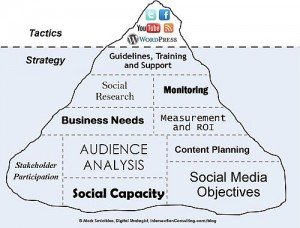If you’re new to social media recruiting, it can be complicated and intimidating. But it doesn’t have to be that way. Just pick your platform carefully, have a plan for posts, and commit to following up on comments to keep it fresh. Above all, remember that most social media users are on mobile devices, not computers. Let’s break it down:
Pick Your Platform
All too often we try to be all things to all people on social media. That’s not a good strategy. Instead, figure out where your customers and potential employees live, work, and play on social media.
For example, many restaurant groups are heavy Facebook users. The way they use Facebook varies by brand. Some brands that are image-conscious build relationships with prospective employees on Facebook to source and interact with prospective employees. They start interacting with prospective employees 8 – 12 weeks before a new restaurant opens.
Twitter is another important recruiting platform, especially in the hospitality industry. Dallas-based Corner Bakery has tweet-ups for #TakeYourPoetToWorkDay, #CraveChat, and #SaladSongs. These chats provide both customer and prospective employee engagement.
On the other hand, if you’re recruiting exempt employees you may not need to look any further than LinkedIn. The industry that you work in may also dictate the platform that you use.
Here’s a real life example. I manage social media for Attorneys Serving the Community. We’re a group of women lawyers who raise money for a local charity every year. Most of the women are on Facebook because they socialize there. But if I were sourcing I wouldn’t start on Facebook because most of my group members don’t list their specialization on their profiles. Many don’t even list their law school. They use Facebook for socializing and they guard their privacy fiercely (at least, as much as they can on Facebook).
The next most active platform in my group is LinkedIn. Almost all of our members have at least a basic LinkedIn profile. But Twitter? Forget about it. This group doesn’t tweet. So, if I were recruiting lawyers, I would definitely choose LinkedIn and wouldn’t even worry about Twitter. I might use Facebook if I wanted to build relationships with them before I approached them about an opportunity, though.
My Attorneys Serving the Community group follows these social media use patterns among all adults, as measured by the Pew Research Center in 2014:
Facebook 58%
LinkedIn 23%
Pinterest 22%
Instagram 21%
Twitter 19%
What platform do your customers utilize the most? Are prospective employees on that platform, too?
Here's a chart to help you think through all of this.
Keep it Visual
Social media is most effective when it’s visual. So, even if you aren’t ready to directly source and interact with potential employees on Facebook, you can still pique interest in your company by posting lots of pictures and videos to get candidates excited. The most powerful visuals are the ones that are created by your current employees since they’re also the most authentic.
Keep it Fresh
The most authentic stories are the ones that are told spontaneously. This is where culture and brand truly collide. Consider the power of posting first day selfies on your Facebook page. Keep your posts fresh and relevant so your followers continuously have new content on their feed.
Since branding is wrapped around social media recruiting, don’t forget to respond to both customer complaints and kudos. Remember, your prospective employees may also be your best customers, so make sure you respond to both the bad feedback as well as the positive comments about your team, product, and service.
Recruiters have a bad reputation for allowing applications to fall into black holes. You can’t afford this reputation on social media, so make sure you’re responsive.
Keep it Mobile
Social media advertising is extremely cost-effective. It’s also great because you can target your audience (just be mindful of EEO rules).
Many successful companies email the sponsored link to candidates (the customer audience) with a link that directs them to a mobile-friendly application page.
Mobile apply is crucial for a successful social media recruiting strategy to work. According to the Pew Internet Center, 91% of adults aged 28 – 29 use their mobile device for social networking. 50% of adults 50+ do so.
The numbers don’t lie. It just doesn’t make sense to have a robust social media recruiting strategy if it’s not supported by a mobile-apply process.

